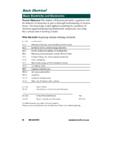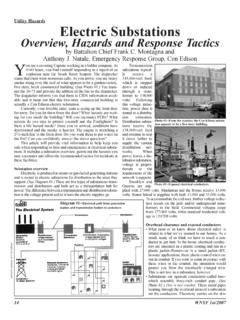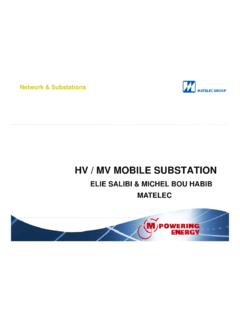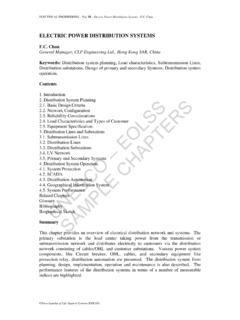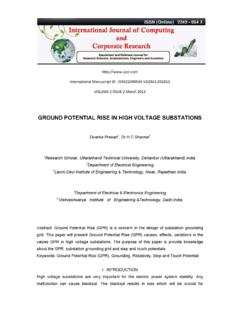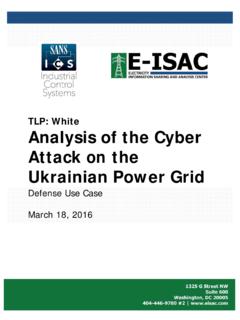Transcription of High Voltage Interfaces for Telecommunications …
1 High Voltage Interfaces for Telecommunications entering ElectricalSubstations and Generating Plantsc Kevin Jacobson, Engineering SummaryThis technical bulletin describes the need for special protection for Telecommunications entering locations that mayexperience high ground potential rise. Certain locations such as electrical generating plants, substations and highvoltage towers contain equipment energized to extremely high voltages, so special care must be taken when installingtelecommunications systems at such sites. telecommunication systems have electrical protection systems designedfor ordinary locations such as typical buildings and residences. At high Voltage electrical sites, the ground grid willrise to a very high Voltage during power system faults and lightning strikes.
2 This is called ground potential rise (GPR).Ordinary telecommunication protection systems do not work when exposed to GPR. Problems such as temporary orpermanent telecommunication outages, damage to equipment and wiring, and worst of all, safety hazard to people onthe site or off the site can occur if protection is not properly designed. So issues ranging from minor annoyance toserious hazards can installation of a special interface, called a high Voltage interface (HVI), is necessary to protect equipmentand personnel from GPR. Not only is a HVI a sensible idea, it may be required by code or local practices. Mosttelecommunications and power companies have standards that cover the installation of HVIs. The installation of aHVI interface is required by Alberta s electrical and Communication and Utility Code (ECUC) and the CanadianElectrical Code (CEC), and recommended by the IEEEs Std 487-2007 Recommended Practice for the Protectionof Wireline Communication Facilities Serving Electric Supply Locations.
3 Both the CEC and IEEE documents areenforced by provincial and municipal laws/codes. IEEE Std 487 recommends that high Voltage isolation be installedon metallic communication circuits wherever the GPR exceeds 1000 volts peak-asymmetric, or where recommendedby a protection engineer. Although a HVI is usually installed to protect against GPR due power line faults, it alsoprovides protection against lightning induced information given in this document is derived from IEEE Std 487-2007, IEEE 367-1997 and from practicesthat have been developed at major telecom service providers and power Why High Voltage Interfaces ?There are four main reasons to install properly designed HVIs on Telecommunications circuits at GPR Protect people from safety hazards, both inside and outside the Protect communications equipment from catastrophic Eliminate nuisance communication WHY HIGH Voltage Interfaces ?
4 Figure 1: Equipment damaged due to ground potential rise at a It is recommended by IEEE practice, it is often required by company practices, and depending on the jurisdic-tion, it may be required by will be explained in the following sections, GPR can be very high at electrical substations and plants, rangingfrom a few hundred volts to tens of thousands of volts. This GPR can be transferred to Telecommunications cable at theplant, and can even appear many kilometers away from the plant location. Obviously this is a widespread human safetyhazard that must be avoided. Any telecommunication equipment throughout a large area can be severely damaged aswell. Fig. 1 shows damaged telecommunication equipment from a substation. Standard protection and an old styletelephone were completely burnt due to high GPR at the substation.
5 Imagine what would have happened if someonewas using that phone at the time of the catastrophic events such as those described above are relatively rare, small GPR events occur frequentlydue to minor events such as trees falling on phase wires, lightning strikes, high winds, and insulator flash-over. Thiscan cause small Voltage bumps which can cause temporary or long-term Telecommunications outages. These mayresult in inconvenience, additional costs due repeated repair and lost productivity, and repeated calls to the telecomservice provider. Considering the financial impact of those minor but frequent events, the installation of a HVI may besensible even at low GPR s electrical and Communication and Utility Code (ECUC - 1999)1states in paragraph 179 Communi-cation and control circuits entering a generating station or substation shall be isolated where necessary to preventthe transfer of unsafe potentials out of the station or substation.
6 More complete technical details are in IEEEs Std487-2007 Recommended Practice for the Protection of Wireline Communication Facilities Serving Electric SupplyLocations. Std 487-2007 describes when it is necessary to install such isolation, gives a good technical backgroundon the principles of GPR and describes general methods of designing appropriate protection for telecommunicationsfacilities in an near stations. HVIs are necessary at most electrical substations , generating plants, and cellular siteslocated on high Voltage has been reissued as the Alberta electrical Utility Code in 2007. It is available from the Safety Codes Council of Alberta for $ 23 telecommunication PROTECTION SYSTEMSC ommunication cableShunt protectorLightning or power contact(a) Protector shunts current to ground at ordinary cableShunt protectorGround potential rise(b) At GPR sites, GPR appears on the ground and is shunted to the telecom pair andappears on any grounded 2: Shunt type telecom telecommunication Protection SystemsTelecommunication systems use a great deal of copper and other metallic cable.
7 Even modern fibre optic cable, thefibres of which are made of non-conductive glass, may contain metallic components such as an aluminum sheath formoisture barrier and even a copper pair. At each building entrance, a standards-compliant protector must be installedto prevent high voltages from entering the building. At a minimum this protector must protect for human safety, but itis also desirable to prevent system outages and equipment damage. High Voltage can appear on metallic cable due toinduction from power lines, contact from power lines, and lightning strikes. These usually occur outside the building,and for that reason the typical telecom protector is a shunt device. As shown in Fig. 2(a), a shunt protector is connectedbetween the tip and ring conductors (the two conductors that make up the pair) and ground.
8 Normally, the shunt deviceis inactive, and appears as a high impedance. When the Voltage exceeds some threshold, usually about 350 V, the shuntdevice activates, and shorts the pair of wires to ground, which will short circuit the Voltage and divert damaging currentto ground. In some installations a series fuse-type device may be included to protect from excessive currents. Shuntdevices can be carbon blocks2, gas tubes, solid state devices, or various hybrids. In order for these protectors to workproperly, they must be connected to a good ground. Also, any metallic components, such as cable sheaths, should beconnected to ground at the service protection devices work when the source of the high Voltage is external to the serviced building, but theydo not help when the high Voltage appears on the ground of the site, which is the case at electrical substations , powergenerating plants and high Voltage towers.
9 The next section describes what can happen at those blocks are quite out-dated, but they may still exist in older telecom 34 GROUND POTENTIAL RISELine to ground faultSubstation ground gridY transformer(line-side windings)Fault current, IfGround grid resistance, RgGround potential rise, GPRP ower line phase wiresFigure 3: Line to ground fault creates ground potential rise at a Ground Potential RiseFig. 3 shows a simplified diagram of a high Voltage location such as an electrical substation or power generatingplant. During a power line fault, a phase wire shorts to ground or another phase wire, which can cause a very highfault current to flow back to the transformer via ground. Power companies endeavor to achieve a low ground gridresistance,Rg, but since high currents may flow, a significant Voltage may still result.
10 For example, if the ground gridresistance isRg= , and the portion of fault current flowing via ground isIf= 2kArms, then the resultingGPR is 1000 what happens if a standard telecom protection scheme is installed at a GPR location? That kind of scheme wasdesigned to shunt high Voltage from the telecom pairs to ground, but during GPR, the Voltage appears on the the example above, the GPR was 1000 Vrms, and typical shunt devices operate at 350 V. As shown in Fig. 2(b),the shunt protector will short the Voltage on the ground to the telecom pair. This will present a hazard to personneland equipment inside the GPR locations, and will divert the high Voltage out of the GPR location, presenting a safetyhazard to customers and equipment over a widespread area. Likewise, any cable sheaths connected to the ground willbe affected.

